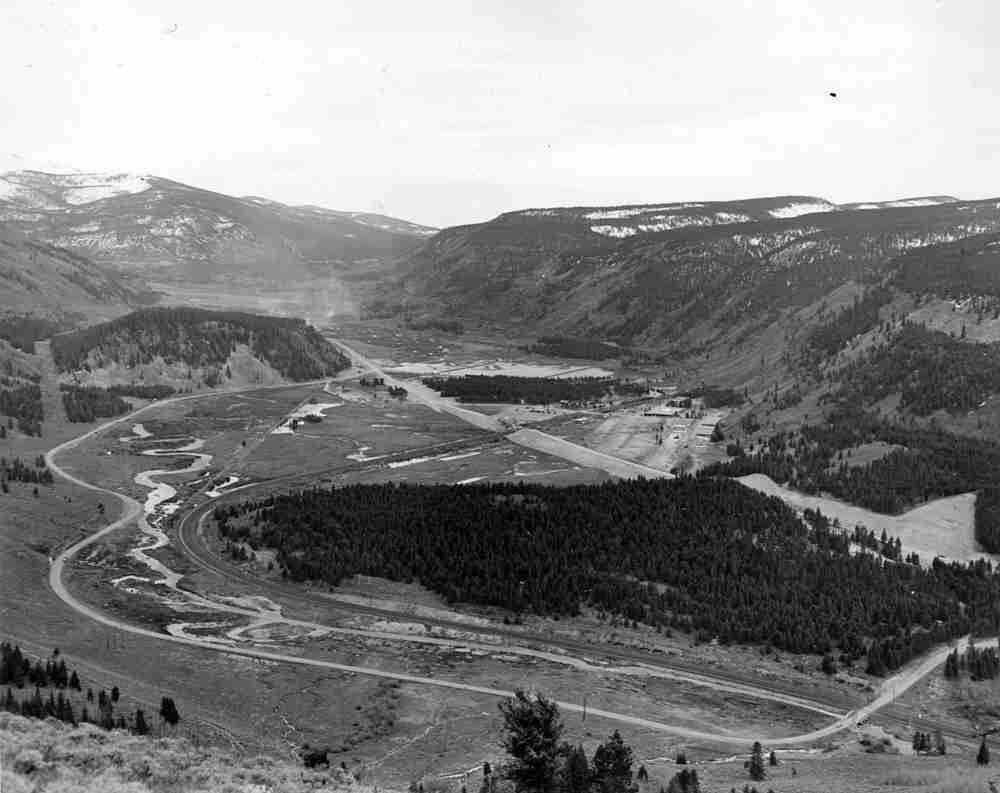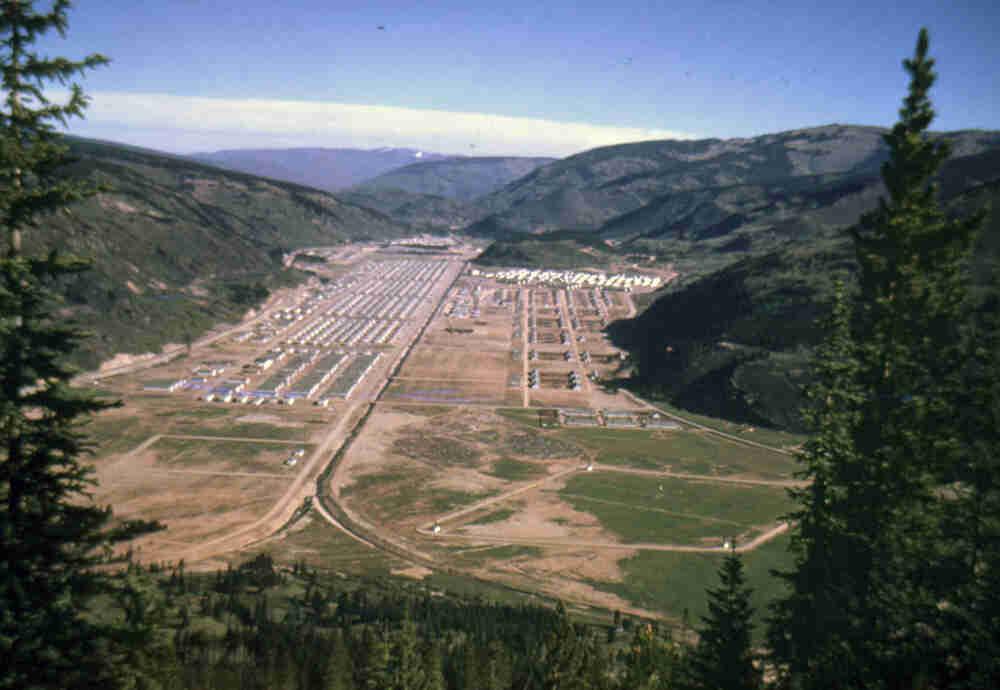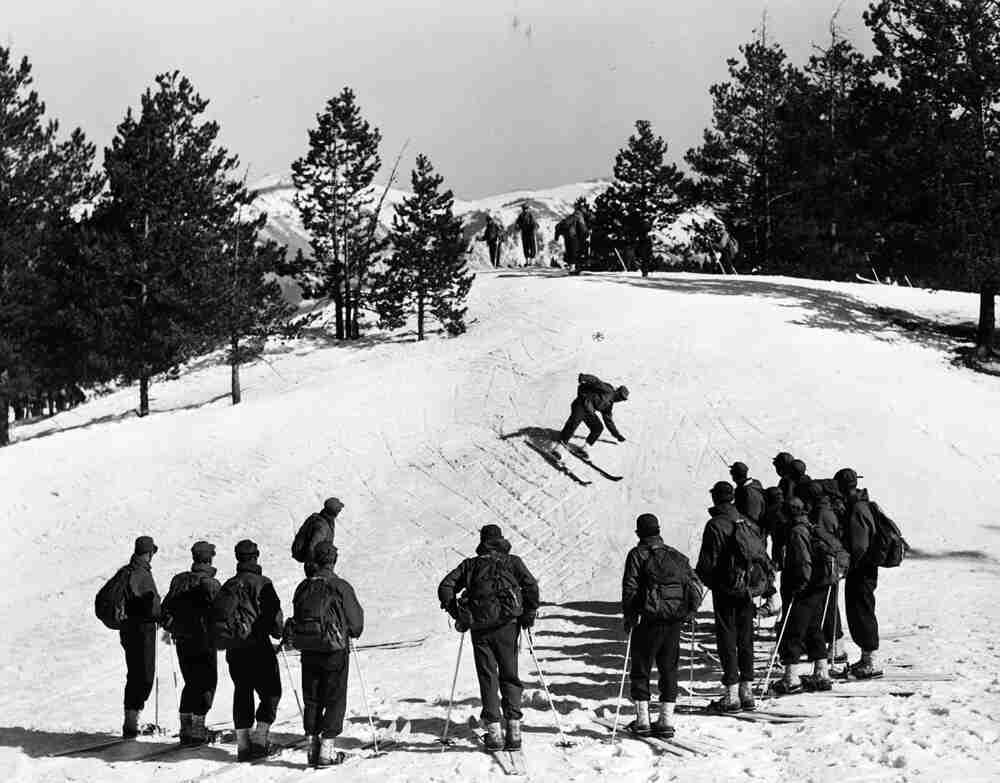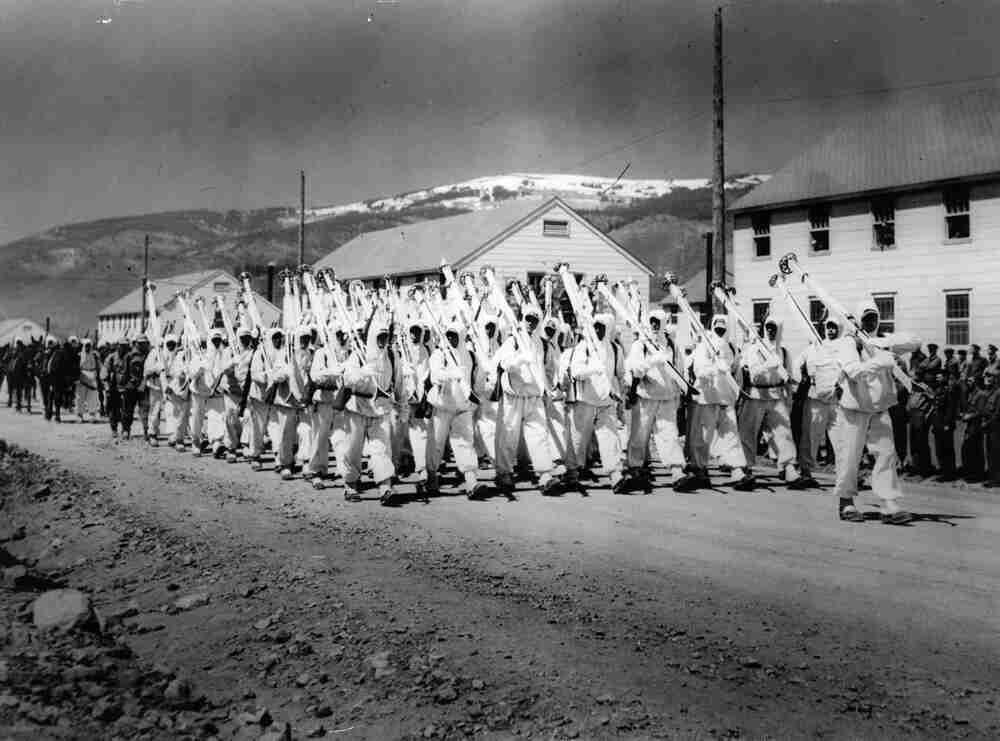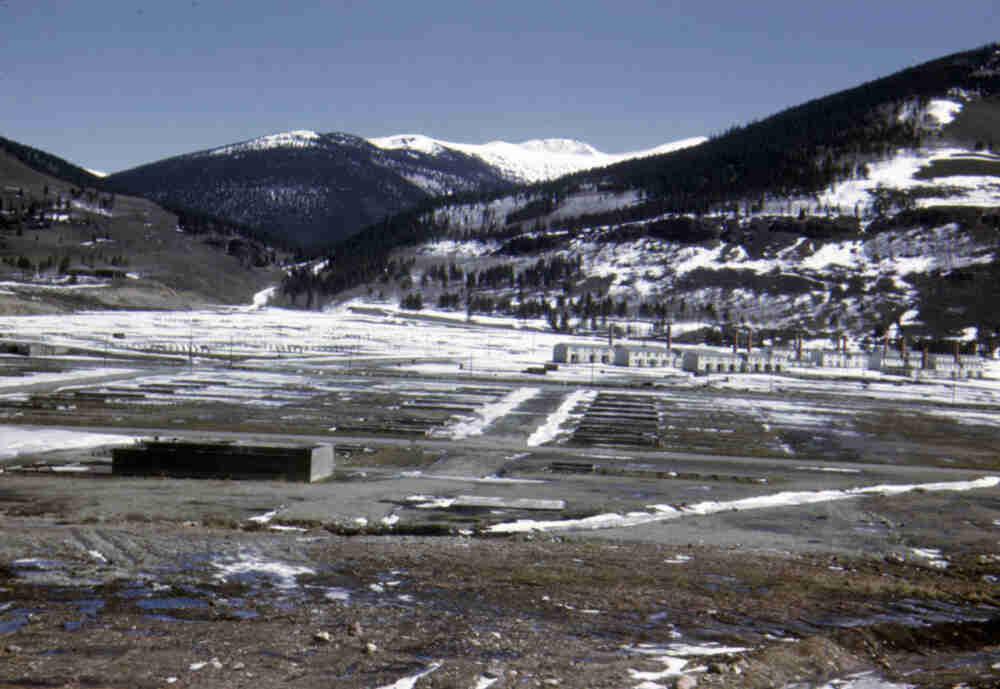Camp Hale
Full Article
Built in the Pando Valley north of Leadville in 1942, Camp Hale served as the training grounds for the US Army’s Tenth Mountain Division during World War II. Troops learned to ski, snowshoe, and climb at the camp, allowing them to perform important operations in northern Italy in early 1945. Many soldiers who trained at the camp later played a crucial role in developing the ski industry in America. After the war, Camp Hale saw occasional military use but was officially deactivated in 1965 and transferred to the White River National Forest for rehabilitation and recreational use.
Origins
In spring 1941, the US Army began to consider establishing a mountain division trained to fight in winter conditions and rugged terrain. After the United States entered World War II, the US Army’s Eighty-seventh Mountain Infantry Regiment began to train near Mt. Rainier in Washington State. Soon it became clear that a larger training site would be needed. The army briefly considered a location near West Yellowstone, Montana, but it was rejected for environmental reasons (the camp would have disturbed the local trumpeter swan population).
In March 1942 the army decided to build its mountain training camp in the Pando Valley north of Leadville. The Pando Valley was originally homesteaded in the 1890s and had been used for ranching until the army acquired it in 1942. The valley met all the requirements for the army’s training camp: it was large enough to support 15,000 troops; it sat at a high elevation of about 9,200 feet, with easy access to 12,000-foot mountains; the Eagle River provided a reliable water source; and Highway 24 and the Denver & Rio Grande Railroad facilitated transportation to and from the camp.
The army began construction of the camp in April 1942. Named Camp Hale, in honor of former Brigadier General Irving Hale, a Denver native, the camp occupied 1,456.8 acres of the Pando Valley floor. The army had to rechannel the meandering Eagle River and several tributaries through the valley to drain the site so that the camp could be built. Highway 24 was also rerouted around the camp. The army completed construction in November 1942 at a cost of $31 million.
Training the Tenth Mountain Division
The US Army’s first and only Mountain Infantry Division took shape at Camp Hale over the winter of 1942–43. New Eighty-fifth and Eighty-sixth Mountain Infantry Regiments were added to the existing Eighty-seventh Regiment to form the Tenth Mountain Division. All the troops arrived at Camp Hale by January 1943, and the valley buzzed with the activity of thousands of soldiers training for war. At its height the camp had more than 1,000 buildings and housed about 15,000 troops.
The vast Camp Hale site included barracks, administration buildings, a hospital, stables, a veterinary center, a field house, and areas used as parade grounds, recreation areas, and gunnery and combat ranges. Enlisted men learned how to survive in winter conditions and fight in the mountains. They practiced skiing, snowshoeing, and technical mountain climbing. Some of the first nylon climbing ropes were tested at Camp Hale.
The ski troops of the Tenth Mountain Division seemed glamorous to the public, but at Camp Hale they were often miserable. Soldiers nicknamed the camp “Camp Hell.” Training was hard, requiring marches and maneuvers with heavy packs at high altitude. Soldiers often suffered from altitude sickness, frostbite, and low morale worsened by a lack of nearby entertainment options. (Leadville was often off-limits to the troops, and in any case it had increased efforts against gambling and prostitution.) Coal smoke from all the trains, stoves, and furnaces in the valley contributed to a persistent cough that the troops called the “Pando Hack.”
In addition to the famed Tenth Mountain Division, Camp Hale also housed other troops, such as the 620th Engineer General Service Company, which arrived at the camp on December 5, 1943. The 200 soldiers who made up this unit were not actually engineers. Like several other army units, the 620th was made up of suspected Nazi sympathizers (mostly Germans) and other opponents of the war. The army lumped them together and dumped them at remote Camp Hale, where they were assigned various menial tasks.
The army also placed several hundred German prisoners of war at Camp Hale. Though communication between prisoners and soldiers was officially forbidden, the German prisoners and the German sympathizers in the 620th understandably got along quite well, exchanging greetings and illegal gifts. Dale Maple, a pro-Nazi Harvard graduate in the 620th, helped a small group of German prisoners to escape. With assistance from a few other men in the 620th, Maple and two Germans slipped away from the lightly guarded camp on February 15, 1944. They made their way to the Mexican border before being arrested by a Mexican customs official on February 18. The two Germans were shipped to another prisoner-of-war camp in Wyoming. Maple was convicted of desertion and aiding the enemy. Originally sentenced to death, he was released in 1951 and lived quietly in San Diego for another fifty years.
Postwar Training and Recreation
 Camp Hale was always meant to be a temporary facility—hence Camp Hale instead of Fort Hale—and the army vacated the camp in June 1944, when the Tenth Mountain Division’s training was complete. After serving with distinction in northern Italy during the winter and spring of 1945, the division was deactivated in October, after the end of the war. Members of the Tenth Mountain Division returned to the United States and played a crucial role in the development of the American skiing industry. Most Colorado ski areas—including Aspen, Vail, and Loveland—trace their origins to the Tenth Mountain Division, as do many other ski areas across the country.
Camp Hale was always meant to be a temporary facility—hence Camp Hale instead of Fort Hale—and the army vacated the camp in June 1944, when the Tenth Mountain Division’s training was complete. After serving with distinction in northern Italy during the winter and spring of 1945, the division was deactivated in October, after the end of the war. Members of the Tenth Mountain Division returned to the United States and played a crucial role in the development of the American skiing industry. Most Colorado ski areas—including Aspen, Vail, and Loveland—trace their origins to the Tenth Mountain Division, as do many other ski areas across the country.
In 1945 the army ordered prisoners of war to dismantle most of the buildings at Camp Hale. These materials were sent to Camp Carson (now Fort Carson) for reuse in new structures. Later, the army reactivated Camp Hale on a limited basis to serve as a Mountain Winter Warfare School and Training Center for soldiers at Fort Carson. In addition, from 1959 to 1964 the CIA used the camp to secretly train about 170 Tibetan soldiers. Camp Hale’s high elevation and mountainous terrain were similar to what the Tibetans would face at home.
At the end of June 1965, the Department of the Army officially closed Camp Hale and transferred the land to the White River National Forest. The camp’s facilities were either given to other government agencies or auctioned off. After the Forest Service acquired the site, it began a long-term process of restoring the Pando Valley to its natural state. These efforts have included burying old building foundations and revegetating the surface. The Forest Service has constructed two campgrounds, the Camp Hale Memorial Campground and the East Fork Campground, on the south and southeastern ends of the site, as well as a picnic area. Interpretive signs allow visitors to take a self-guided tour of the old Camp Hale site.
The army continued to hold occasional training sessions at the Camp Hale site into the 1990s with a special-use permit from the Forest Service. Starting in the late 1990s, the US Army Corps of Engineers established the Camp Hale Military Munitions Project to remove any potentially hazardous munitions from the area. Previous sweeps had occurred in 1946 and 1965, but new work in the early 2000s uncovered several dozen live items that had to be destroyed. It is also possible that chemical weapons were tested in the area. The Corps of Engineers continues to work with the Forest Service to inform visitors about munitions and to respond to reports of munitions at the site.
In 2015, as part of the National Forest Foundation’s Treasured Landscapes campaign, the Forest Service collaborated with the National Forest Foundation and local stakeholders to develop a proposal to restore wetlands in the Pando Valley. Building Camp Hale had required forcing the Eagle River into a straight, narrow ditch, destroying about 70 percent of the valley’s historic wetlands. The plan would allow the Eagle River to meander as it formerly did, increasing the river’s length by more than three miles and restoring up to a quarter of the wetlands. The $30 million proposal is in a public comment and review period until summer 2016.
10th Grade
Camp Hale served as the training grounds for the US Army’s Tenth Mountain Division during World War II. It was built in the Pando Valley north of Leadville in 1942. Troops learned to ski, snowshoe, and climb at the camp. The division applied its training in combat in northern Italy in 1945. Many soldiers who trained at the camp later played a role in developing the Colorado ski industry. Camp Hale was officially deactivated in 1965. It was transferred to the White River National Forest for rehabilitation and recreational use.
Origins
During World War II, the army needed to train soldiers to fight in winter conditions and high altitude. The US Army’s Eighty-Seventh Mountain Infantry Regiment began to train near Mt. Rainier in Washington State, but it soon became clear that a larger training site would be needed. The army considered a location near West Yellowstone, Montana, but it was rejected for environmental reasons (the camp would have disturbed the local trumpeter swan population).
In March 1942, the army decided to build its mountain training camp in the Pando Valley north of Leadville. The Pando Valley had been used for ranching until the army acquired it in 1942. The valley met all the requirements for the army’s training camp: it was large enough to support 15,000 troops, sat at a high elevation of about 9,200 feet, and had easy access to 12,000-foot mountains. The Eagle River provided a reliable water source and a highway and a railroad provided transportation.
The army began construction of the camp in April 1942. It was named Camp Hale in honor of former Brigadier General Irving Hale, a Denver native. The camp occupied 1,457 acres of the Pando Valley. To build the camp, the army had to rechannel the meandering Eagle River and several tributaries through the valley. Highway 24 was rerouted around the camp. The army completed construction in November 1942 at a cost of $31 million.
Training the Tenth Mountain Division
The army’s first and only Mountain Infantry Division took shape at Camp Hale over the winter of 1942–43. The Tenth Mountain Division was created out of several regiments. All the troops arrived at Camp Hale by January 1943, and the valley buzzed with the activity of thousands of soldiers training for war. At its height, the camp had more than 1,000 buildings and housed about 15,000 troops.
The vast Camp Hale site included barracks, administration buildings, a hospital, stables, a veterinary center, a field house, and areas used as parade grounds, recreation areas, and gunnery and combat ranges. Enlisted men learned how to survive in winter conditions and fight in the mountains. They practiced skiing, snowshoeing, and technical mountain climbing. Some of the first nylon climbing ropes were tested at Camp Hale.
The ski troops of the Tenth Mountain Division seemed glamorous to the public, but at Camp Hale they were often miserable. Soldiers nicknamed the camp “Camp Hell.” Training required marches and maneuvers with heavy packs at high altitude. Soldiers suffered from altitude sickness and frostbite. Low morale was worsened by a lack of nearby entertainment options. Leadville was often off-limits to the troops. Coal smoke from all the trains, stoves, and furnaces in the valley contributed to a persistent cough that the troops called the “Pando Hack.”
In addition to the famed Tenth Mountain Division, Camp Hale also housed other troops. The 620th Engineer General Service Company arrived at the camp on December 5, 1943. The 200 soldiers in this unit were not actually engineers but suspected Nazi sympathizers (mostly Germans) and other opponents of the war. The army grouped them together and sent them to remote Camp Hale, where they were assigned various menial tasks.
The army also placed several hundred German prisoners of war at Camp Hale. Communication between prisoners and soldiers was officially forbidden, but the German prisoners and German sympathizers in the 620th got along quite well, exchanging greetings and illegal gifts. In February 1944, Dale Maple, a pro-Nazi Harvard graduate in the 620th, helped a small group of German prisoners escape. They made it to the Mexican border before being arrested by a Mexican customs official. The two Germans were shipped to a prisoner-of-war camp in Wyoming. Maple was convicted of desertion and aiding the enemy. He was sentenced to death, but was released in 1951. He lived quietly in San Diego for another fifty years.
Postwar Training and Recreation
The Tenth Mountain Division served with distinction in northern Italy during the winter and spring of 1945. Some members of the Tenth Mountain Division returned to the United States and helped to develop the Colorado ski industry. Most Colorado ski areas, including Aspen, Vail, and Loveland, trace their origins to the Tenth Mountain Division, as do many other ski areas across the country.
In 1945 prisoners of war dismantled most of the buildings at Camp Hale. The materials were sent to Camp Carson (now Fort Carson) for reuse in new structures. Later, the army reactivated Camp Hale on a limited basis to serve as a Mountain Winter Warfare Training Center for soldiers at Fort Carson. From 1959 to 1964, the CIA used the camp to secretly train about 170 Tibetan soldiers, as the high elevation and mountainous terrain were similar to the Tibetan landscape.
In June 1965, the Department of the Army officially closed Camp Hale and transferred the land to the White River National Forest. The camp’s facilities were either given to other government agencies or auctioned off. After the Forest Service acquired the site, it began a long-term process of restoring the Pando Valley to its natural state. These efforts included burying old building foundations and revegetating the surface. The Forest Service constructed two campgrounds, the Camp Hale Memorial Campground and the East Fork Campground, and a picnic area. Interpretive signs allow visitors to take a self-guided tour of the old Camp Hale site.
The army continued to hold training sessions at the Camp Hale site into the 1990s with a special-use permit from the Forest Service. Starting in the late 1990s, the US Army Corps of Engineers began to remove potentially hazardous buried weapons from the area. While the area had been checked before, some items were discovered in the 2000s. It is also possible that chemical weapons were tested in the area. The Corps of Engineers continues to work with the Forest Service to inform visitors about munitions and respond to reports of munitions at the site.
In 2015 the Forest Service worked with the National Forest Foundation and local stakeholders to develop a proposal to restore wetlands in the Pando Valley. This was part of the National Forest Foundation’s Treasured Landscapes campaign. Building Camp Hale had forced the Eagle River into a straight, narrow ditch, destroying about 70 percent of the valley’s historic wetlands. The new plan will allow the Eagle River to meander as it formerly did. It will increase the river’s length by more than three miles and restore up to a quarter of the wetlands. As of November 2016, the $20 million proposal is being reviewed under the National Environmental Policy Act process.
8th Grade
Camp Hale served as the training ground for the US Army’s Tenth Mountain Division during World War II. It was built in the Pando Valley north of Leadville in 1942. Troops learned to ski, snowshoe, and climb at the camp. The division applied its training in combat in northern Italy in 1945. Many men who trained at the camp later played a role in developing Colorado’s ski industry. Camp Hale was closed in 1965. It was transferred to the White River National Forest for rehabilitation and recreational use.
Origins
During World War II, the US Army created Camp Hale to train soldiers to fight in winter conditions and high altitudes. The mountain training camp was built in the Pando Valley near Leadville. The valley met all the requirements for the army’s camp. It was large enough to support 15,000 troops. It sat at a high elevation and had easy access to 12,000-foot mountains. The Eagle River provided a reliable water source, while highways and railroads provided transportation.
The army built the camp in April 1942. It was named Camp Hale in honor of Denver native Brigadier General Irving Hale. The camp used 1,457 acres of the Pando Valley. To build the camp, the army had to relocate the Eagle River. Highway 24 was rerouted around the camp. The army completed construction in November 1942 at a cost of $31 million.
Training the Tenth Mountain Division
The Tenth Mountain Division was the Army’s first and only Mountain Infantry Division. It was created out of several regiments. The troops arrived at Camp Hale by January 1943. The valley buzzed as thousands of soldiers trained for war. At its height, the camp had more than 1,000 buildings and housed about 15,000 troops.
The vast Camp Hale site included barracks, a hospital, stables, a veterinary center, and a field house. It had parade grounds, recreation areas, and gunnery and combat ranges. Enlisted men learned how to survive in winter conditions and fight in the mountains. They practiced skiing, snowshoeing, and technical mountain climbing. Some of the first nylon climbing ropes were tested at Camp Hale.
Training was difficult and the soldiers were often miserable. Soldiers nicknamed the camp “Camp Hell.” Training required marches and maneuvers with heavy packs at high altitude. Soldiers suffered from altitude sickness and frostbite. Low morale was worsened by a lack of nearby entertainment options. Leadville was often off-limits to the troops. Coal smoke from all the trains, stoves, and furnaces filled the valley. Some soldiers got a cough that they called the “Pando Hack.”
Camp Hale also housed other troops. The 620th Engineer Company arrived at the camp in 1943. The 200 soldiers in this unit were not actually engineers, but were suspected Nazi sympathizers (mostly Germans) and other opponents of the war. The army grouped them together and sent them to remote Camp Hale. Here they were assigned various menial tasks.
The army also jailed German prisoners of war at Camp Hale. Communication between prisoners and soldiers was forbidden. But the German prisoners and the German sympathizers in the 620th got along well. They exchanged greetings and illegal gifts. In 1944 Dale Maple, a pro-Nazi member of the 620th, helped some German prisoners escape. Maple and two Germans slipped away from the camp. They made it to the Mexican border before being arrested. The two Germans were shipped to a prisoner-of-war camp in Wyoming. Maple was convicted of desertion and aiding the enemy. He was sentenced to death, but was released in 1951. He lived quietly in San Diego for another fifty years.
The Tenth Mountain Division fought in northern Italy during the winter and spring of 1945. They served with distinction during the war. The training they received at Camp Hale helped the US defeat Italy and Germany.
Postwar Training and Recreation
The Tenth Mountain Division was shut down at the end of the war. Some members of the Tenth Mountain Division returned to Colorado. They helped to develop the American skiing industry. Most Colorado ski areas trace their origins to the Tenth Mountain Division. This includes Aspen, Vail, and Loveland.
In 1945 Camp Hale was torn down. The materials were sent to Fort Carson. In the 1950s, Fort Carson used Camp Hale as a Mountain Winter Training Center. From 1959 to 1964, the CIA used the camp to secretly train Tibetan soldiers. Camp Hale’s elevation and terrain were similar to what the Tibetans faced at home.
In June 1965, the Army closed Camp Hale. The land was transferred to the White River National Forest. The Forest Service began to restore the Pando Valley to its natural state. They buried building foundations and replanted the area. Forest Service constructed two campgrounds and a picnic area. Interpretive signs allow visitors to take a self-guided tour of the old Camp Hale site.
In the 1990s, the Army began to remove buried weapons from the area. While the area had been checked before, some items continue to be discovered. They continue to work to rid the area of hidden or buried military supplies.
Since 2015, the Forest Service has worked to restore the valley’s wetlands. While building Camp Hale, workers forced the Eagle River into a straight, narrow ditch. This destroyed about 70 percent of the valley’s wetlands. The new plan will allow the Eagle River to run as it did before Camp Hale, increasing its length by more than three miles. Up to a quarter of the wetlands will be restored. The $30 million proposal is still being reviewed.
4th Grade
Camp Hale was created to train US soldiers to fight in the mountains during World War II. The camp was built in the Pando Valley near Leadville in 1942. There, troops of the Tenth Mountain Division learned to ski, snowshoe and climb. They used their training to fight in the Apennine Mountains in Italy in 1945. After the war, soldiers who trained at the camp helped build ski areas in Colorado. Camp Hale is now part of the White River National Forest.
Origins
In 1942 the United States was involved in World War II. The US Army created Camp Hale to train soldiers to fight in the mountains during winter. The army built its training camp near Leadville. It was a good place for the camp. It could house 15,000 troops. It had a high elevation and was near 12,000-foot mountains. The Eagle River provided water. A highway and a railroad provided transportation.
It was named Camp Hale for Brigadier General Irving Hale, who was from Denver. The camp used 1,457 acres of the Pando Valley. To build the camp, the army had to move the Eagle River and a highway.
Training the Tenth Mountain Division
The troops of the Tenth Mountain Division arrived at Camp Hale by January 1943. Soon the camp had more than 1,000 buildings and about 15,000 men.
Camp Hale was enormous. It had barracks, a hospital, stables, a veterinary center and a field house. It had parade grounds, recreation areas, and gun and combat ranges. Men learned how to survive in winter conditions and fight in the mountains. They practiced skiing, snowshoeing, and mountain climbing.
Training was hard. Camp Hale’s soldiers were often miserable. They nicknamed the camp “Camp Hell.” They had to practice with heavy packs at high altitude. Soldiers got altitude sickness and frostbite. Coal smoke from trains, stoves, and furnaces filled the valley. Some soldiers got a cough they called the “Pando Hack.”
Camp Hale also housed other troops. One was a unit of soldiers who supported the Germans or opposed the war. The army grouped them together and sent them to far-off Camp Hale. Here they were assigned basic jobs.
There were also German prisoners of war at Camp Hale. Once, some German prisoners escaped. They made it to Mexico before being arrested.
The Tenth Mountain Division fought in northern Italy in the winter of 1945. Their training helped the US defeat Italy and Germany during World War II.
Postwar Training and Recreation
After the war, members of the Tenth Mountain Division helped develop Colorado’s ski areas, including Aspen, Vail, and Loveland.
In 1945 the buildings at Camp Hale were torn down. The materials were sent to Fort Carson to reuse. Camp Hale was sometimes used as an army training center.
In 1965 the army closed Camp Hale. They gave the land to the White River National Forest. The Forest Service began to restore the valley to its natural state. They buried building sites and planted trees. They made two campgrounds and a picnic area. Visitors can take a tour of the old Camp Hale site.
In 2015 the Forest Service worked to restore the Pando Valley. Camp Hale had moved the Eagle River into a straight, narrow ditch. This destroyed most of the valley’s wetlands. They are working to move the Eagle River so it will run as it did before Camp Hale. The river’s length will be three miles longer. If approved by the Forest Service, the project will restore much of the wetlands.


